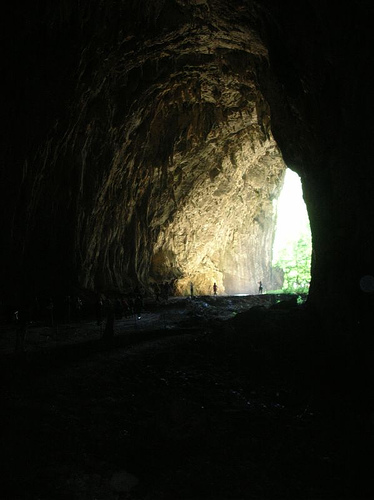

about it poured a drink-offering to all the dead,
first with mead and thereafter with sweet wine,
and for the third time with water, and I sprinkled white meal
thereon (…),
I took the sheep and cut their throats over the trench,
and the dark blood flowed forth, and lo,
the spirits of the dead that be departed gathered them from out
of Erebus (…),
then did I speak to my company and command them
to flay the sheep which even now lie slain by the pitiless
sword,
and to consume them with fire, and to make prayer to the gods,
to mighty Hades and to dread Persephone.
(The Odyssey, Book XI)
Location: Karst Plateau Map
Average Temperature: 12 °C
Open: throughout a year
Contact Information:
Tel. +386 (0)5 70 82 100
Fax: +386 (0)5 70 82 105
Email: psj.info@psj.gov.si
Škocjan Caves is a massive underground system in
Karst Plateau of South- West Slovenia. In 1986 it was designated as
UNESCO World Heritage Site. First reference to these magnificent
underground canyon of the Reka River date back to the 2nd century BC
when it was described by Posidonius of Apamea (135 BC). Skocjan was
inhabited for the past 10,000 years (Mesolithic, Neolithic, Bronze
Age and Iron Age) and the tradition of veneration continued to the
Roman times. Ancient people believed that this is the entrance to
the kingdom of Aides or Hades, Kingdom of the Dead. Sounds of
flowing water inside these natural passages convinced that this was
a legendary river that all dead had to cross. Many ancient pilgrims
flocked here in hopes to met their dead relatives. Those who were
foolish enough to venture inside these labyrinths often had their
wishes granted. Ancient maps portrayed this destination as an
entrance to underworld. Later they were seen on Lazius-Ortelius map
(1561) and Mercator's Novus Atlas (1637).
Today the caves are open to the public throughout a year. They were
first visited by tourists in 1819 and that tradition continues to
this day. Parking area around these underground system is available
and it is free of charge. All tour visits are guided and last about
1 hour and 30 minutes with a total length of 3 kilometers. Take
comfortable shoes and something warm. The inside temperature in the
cave is at average of 12 °C throughout a year. There is also
underwater exploration of the cave, but this must be arranged with
the Škocjan Caves Park Public Service Agency that manages the caves
and give permits.
The river flows into the Škocjan Caves in the
Great Valley and flows 34 km underground to the Adriatic Sea , where
it flows as a source of the Timava River . In rainy weather, the
view of the vast river that disappears underground at the bottom of
the Great Valley, 160 m below the surface, is magnificent and
terrifying. The area of the Škocjan Caves Regional Park is
archaeologically extremely rich and indicates a continuous
settlement here since ten thousand years ago. The valuable and rich
archeological finds in the Musja Cave , where the cave sanctuary was
at the end of the Bronze Age and in the Iron Age , indicate the
influence of Greek civilization. This area was certainly one of the
most important pilgrimage sites in the three thousand years
agoEurope, and especially in the Mediterranean , where it had an
important cultic significance in connection with the afterlife and
communication with the ancestral spirits.
History
The first document recorded is from 1819, an official report to the
District Office in Sežana , in which an unknown writer describes the
Škocjan Caves. 20 years later, Jakob Svetina , a plumbing master
from Trieste , climbed 120 m farther down the river with a raft to
find out how to get water for the Trieste water supply system. At
that time (in 1851) the miners from Idrija went down the deepest -
450 m.
Voice of the beauty of the Škocjan Caves spread throughout Europe in
the 19th century. The cave attracted speleologists dr. Adolf Schmidl
and the Miller Brothers from Vienna, from the Czech Republic Anton
Hanke and William Putick and from Trieste Joseph Marinic , and later
many Italians . The first breaking paths were led by men from nearby
villages who were also excellent guides.
The part of the caves where the tourist tour begins today - this is
the Silent Cave - was discovered by native guides in 1904. The first
explorers were not interested in the cave because it is a blind
sleeve without running water. In 1938, a shorter tunnel was cut from
the Globočak valley for more convenient access for visitors. In 1958
electric lighting was installed in the caves.